I’m Jai Sanchez and I’m spending my summer in Santa Barbara, California studying marine and coastal life at UCSB/the REEF (Research Experience & Education Facility). The REEF is part of the Marine Science Institute’s (MSI) education and outreach program. The REEF is dedicated to teaching everyone about coastal biology, marine life, and how to preserve ocean life. Since the REEF is a part of MSI, we also study and conduct research. One of our current research experiments is how heat waves may affect the red urchin’s development of their gonads, commonly known as uni. Uni is a multi-million-dollar fishing industry in California and is sent all over the world.
This past Monday, I continued my internship at the Research, Experience, and Education Facility (R.E.E.F.) in Santa Barbara, California. To start off my day, I attended the weekly aquarist meeting where we explored the capital work that would be taking place, which included air plumbing and line pigging the ‘raw raw’ water line. After the meeting, I assisted in a touch tank activity for an outreach program and engaged the students to learn more about the sea stars in Santa Barbara’s maritime community.
On Tuesday, I explored the marine heatwave research system led by the Special Systems Aquarist, Sophia, by drying the Giant Kelp used for the feeding trials. After measuring and weighing the kelp, Will, another volunteer, and I ate a small piece of kelp to see what it tasted like. The kelp was gummy because of the microbial slime they produce, which is why kelp is utilized as a stabilizer in certain toothpastes and ice cream! Later on in the day, I worked with Allen, the other Special Systems Aquarist, to pig the line. Pigging the line is when the water lines are thoroughly cleaned by removing any small blockages that lay inside it to ensure the water flow is sufficient. Because the water line was unfiltered water, when I got sprayed in the process, I left the REEF soggy and dirty.
The next day, Allen and I measured the layout for air plumbing to place PVC lines on the ceiling beams to provide oxygen to all the tanks in the future. I had a good time learning how to use PVC cutters and how to set up an air plumbing system. After plumbing, I prepped the food for all the animals in the REEF and ate my lunch. Then, I received a Seawater System tour with Nick, an MSI technician, where I viewed the filter and pump house. The new pump house, built around the old pump house, pumps water from the ocean to the filter house for all the labs and facilities that require seawater. The filter house filters this water through sand to get all the debris and small animals out before sending the water to where it needs to go. Afterwards, Marine, Gianna, and I stayed at the REEF to shuck mussel samples.
On Thursday, Josie, the REEF’s program coordinator, and I reviewed the schedule and how to read it as part of exploring what a program coordinator does. We discussed college life, especially the dining situation and where to get food. Afterwards, Gianna, Scott, and I drained the abalone holding facility tanks in order to tag the abalones. The abalones were tagged using super glue so we can track their growth and metrics in the future.
This Friday, siphoning took place to ensure pristine water quality for our animals. Scott took some volunteers and I to a ‘board’ meeting, which entailed a surfing lesson for a future program! This was my first time in the ocean and surfing, so I was very excited to catch my first wave standing up. Unfortunately, the scheduled program after the ‘board’ meeting was canceled, so I got to spend time talking with Sophia and Allen about school in general.
Saturday was my last open doors at the REEF this summer. I spent the first two hours engaging multiple families and students with our touch tanks, which models our maritime community. Everything you find in the REEF, (minus one clownfish) you will see in Santa Barabara’s coast from sunburst anemones to bat sea stars. I spent the rest of my shift outdoors tallying how many people came into the reef. Afterwards Daisy, an undergraduate volunteer and I went swimming for a couple hours, which wrapped up week three of my internship here at the REEF.

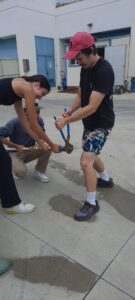
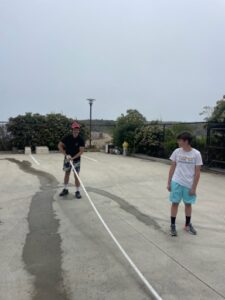
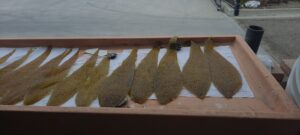
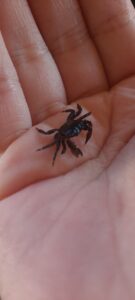
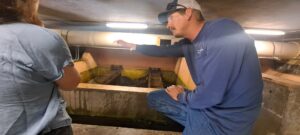
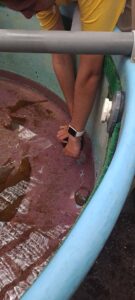
Jai, by the sounds of it, you are having a very exciting, very well-rounded experience in California! Did you willingly try the kelp?
I’m having a great time in Santa Barbara! It was me who suggested eating the leftover kelp as a joke and one of the boys I work with did and it said it wasn’t bad so I tried it. It was very salty, I guess to be expected cominy directly from the sea and wasn’t bad minus the goo it produced.